Yamaha MLANMIXERE, MLANMIXER User Manual
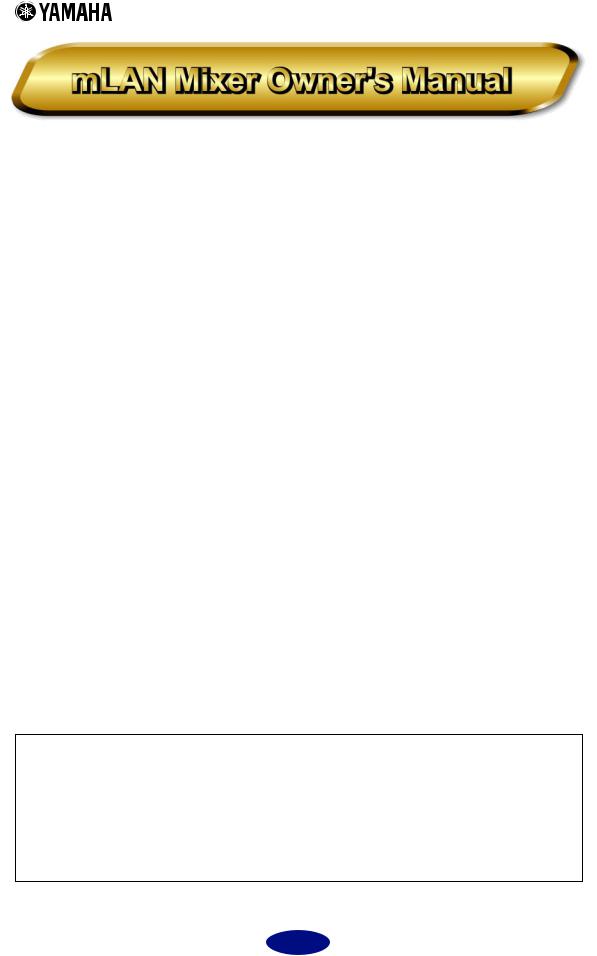
Table of Contents
What is mLAN Mixer? .......... |
2 |
Starting mLAN Mixer........... |
2 |
Windows98/95 environment. 2 |
|
Macintosh environment ........ |
2 |
Top Panel Screen ................. |
3 |
Menu Bar.............................. |
4 |
File menu .............................. |
4 |
View menu............................ |
4 |
Option .................................. |
4 |
Help menu ............................ |
5 |
Basic Controls....................... |
6 |
Control knobs ....................... |
6 |
Numeric field box ................. |
6 |
Input Channel Settings |
|
(Input Section) .................. |
7 |
Master Track Settings |
|
(Output Section) ............... |
9 |
Channel Tab Window......... |
10 |
EQ (Equalizer)...................... |
11 |
Dynamics ............................ |
11 |
Delay................................... |
12 |
Effect Tab Screen................ |
13 |
System Tab Screen ............. |
14 |
mLAN8P.............................. |
14 |
mLAN8E .............................. |
16 |
Block Diagram (Audio)....... |
17 |
mLAN8P.............................. |
17 |
mLAN8E .............................. |
18 |
Data List.............................. |
19 |
Effect Type .......................... |
19 |
Effects Parameters................ |
20 |
Dynamics ............................ |
29 |
Dynamics Library................. |
34 |
EQ Library ........................... |
35 |
•The software and this owner’s manual are exclusive copyrights of Yamaha Corporation.
•Copying of the software or reproduction of this manual in whole or in part by any means is expressly forbidden without the written consent of the manufacturer.
•Yamaha makes no representations or warranties with regard to the use of the software and documentation and cannot be held responsible for the results of the use of this manual and the software.
•Copying of the commercially available music sequence data and/or digital audio files is strictly prohibited except for your personal use.
•The company names and product names in this Owner’s Manual are the trademarks or registered trademarks of their respective companies.
•The screen displays as illustrated in this Owner’s Manual are for instructional purposes, and may appear somewhat different from the screens which appear on your computer.
This owner’s manual assumes that you are already familiar with basic Windows/Macintosh operation. If you are not, please refer to the owner’s manual which came with your Windows/Mac OS software before using mLAN Mixer.
For information about hardware requirements, the interconnection of devices and the installation of the mLAN Mixer software, refer to the separate “Installation Guide” as well as the owner’s manual for the respective mLAN device.
This owner’s manual is applicable to the mLAN Mixer for both Windows and Macintosh. The screen illustrations are mainly taken from the mLAN Mixer for Macintosh.
©2000 Yamaha Corporation
1

What is mLAN Mixer?
mLAN Mixer is a software application that enables you to control the mixer functions of the mLAN8P/ mLAN8E from the computer as if you were controlling a normal mixing console. mLAN Mixer offers independent EQ and dynamics settings for each channel, making it possible to perform detailed mixing operation.
Starting mLAN Mixer
After installing mLAN Mixer and making the necessary connections, follow the steps below to start the software.
Use mLAN Patchbay to set up the COM port for Windows.
 Windows98/95 environment
Windows98/95 environment
In Windows98/95, select [Start | Program (P) | YAMAHA mLAN Mixer], then select “mLAN Mixer.”
 Macintosh environment
Macintosh environment
Open the “YAMAHA mLAN Mixer” folder on the computer and double-click the “mLAN Mixer” icon.
2

Top Panel Screen
The following screen appears when you start mLAN Mixer.
If there are multiple mLAN8P/mLAN8Es connected to the bus (system) of a Macintosh computer, a window appears, prompting you to select the device you wish to control with the mLAN Mixer. You can select multiple devices to control simultaneously from the mLAN Mixer. If you are using a PC that runs Windows98/95, an mLAN8P/mLAN8E connected serially to the computer will be automatically selected.
The mLAN8P controlling screen and the mLAN8E controlling screen are slightly different. This manual references the mLAN8P controlling screen. However, functions that differ are also explained.
parameters
input channels (input section) |
master track (output section) |
|
3

Menu Bar
 File menu
File menu
New: ......................... |
Creates a new Mixer file. |
Open: ....................... |
Opens an existing Mixer file. |
Save: ......................... |
Overwrites an existing file with the currently-edited Mixer file. |
Save As: .................... |
Saves the currently-edited Mixer file with a different name. |
Quit:......................... |
Closes mLAN Mixer. |
“Save” and “Save As” do not save the Level, Meter Source, Peak Hold, Fall Time, and Word Clock settings.
The edited settings for the mLAN mixer will be lost when the power to the mLAN8P/mLAN8E is turned off. (This does not apply to the parameters accessible from the control panel of the unit.) Be sure to store the necessary settings using the File menu.
 View menu
View menu
Hide/Show Parameter:............... Displays or hides various parameters in the tab screens.
 Option
Option
Init Channel (Initialize Channel): ...... Opens the Init Channel dialog that is used to initialize the settings for selected channels or all channels.
Preference (Windows only): ................ Opens the Preference dialog that is used to customize the menu shortcut keys.
4
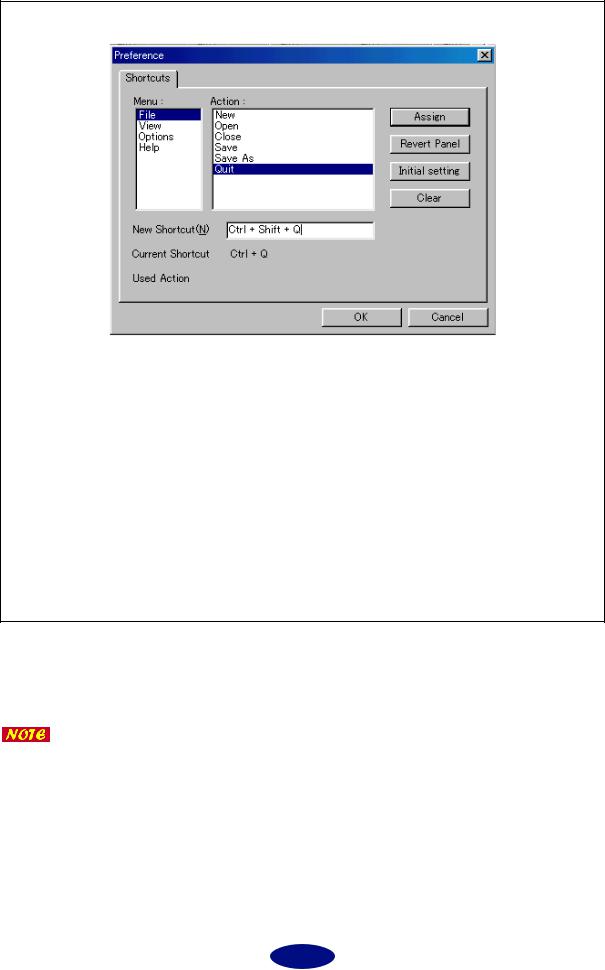
Preference dialog (Setting the shortcuts) (Windows only)
Shortcuts
1.Select a menu and action from the Menu and Action columns for which you wish to set a shortcut. In the example above, [New] in the File menu is selected.
2.Click [New Shortcuts] and press the desired shortcut key. In the example above, the [Q] key is pressed while the [Ctrl] and [Shift] keys are held down. If the shortcut key has already been assigned to another “Action,” the “Used Action” column displays the name of the “Action.”
3.Click [Assign]. The “Current Shortcut” column displays the selected shortcut.
4.Press the [OK] button to confirm the selected shortcut setting. If you do not wish to change the setting, click [Cancel].
Revert Panel: ......... Returns to the previous setting.
Initial setting:........ |
The shortcut is set to the [Ctrl] key plus the first letter of the |
|
selected Action. |
Clear:...................... |
Clears the setting. |
Direct Mode: ........... You can temporarily place mLAN Mixer in Direct mode while you are controlling the mLAN8E. This function is not available with the mLAN8P.
Refer to the Owner’s manual for the mLAN8E for more information on Direct mode.
 Help menu
Help menu
About mLAN Mixer (A): ............ Displays the version information for the mLAN Mixer (Windows).
5
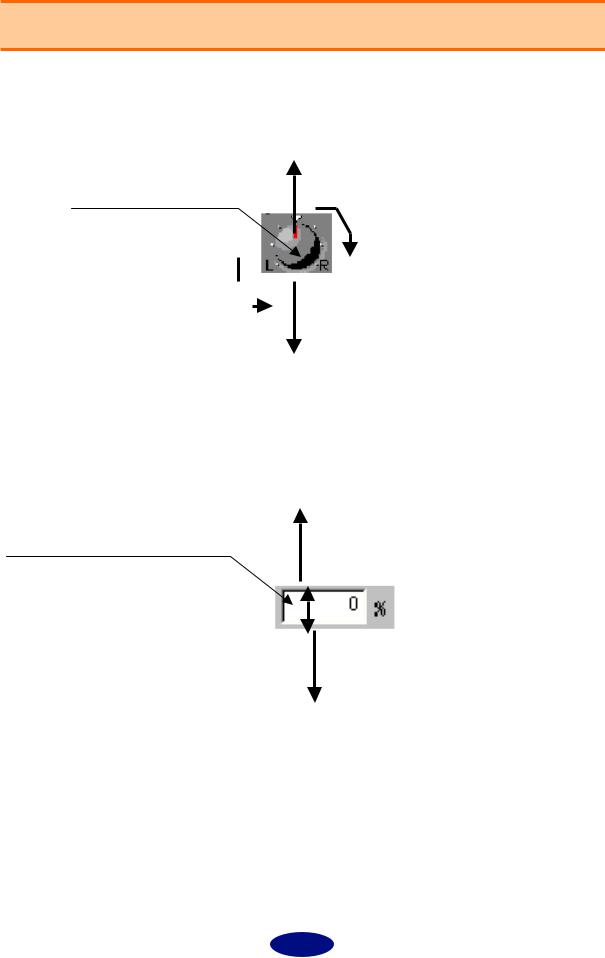
Basic Controls
 Control knobs
Control knobs
To rotate a control knob clockwise, click-and-hold the mouse on the knob while dragging upward. Drag down to rotate the knob counter-clockwise.
Click-and-hold the mouse on a control knob.
Move the mouse downward to rotate  the knob counter-clockwise.
the knob counter-clockwise.
Move the mouse upward to rotate the knob clockwise.
 Numeric field box
Numeric field box
Click-and-hold the mouse and drag upward in a number box to continuously increment the value. Drag the mouse downward to decrement the value.
You can also enter the value directly by clicking (double-clicking) the box.
Click-and-hold down the mouse button in the box.
(The pointer changes to an arrow.) Drag the mouse upward to continuously increment the value.
Drag the mouse downward to continuously decrement the value.
6
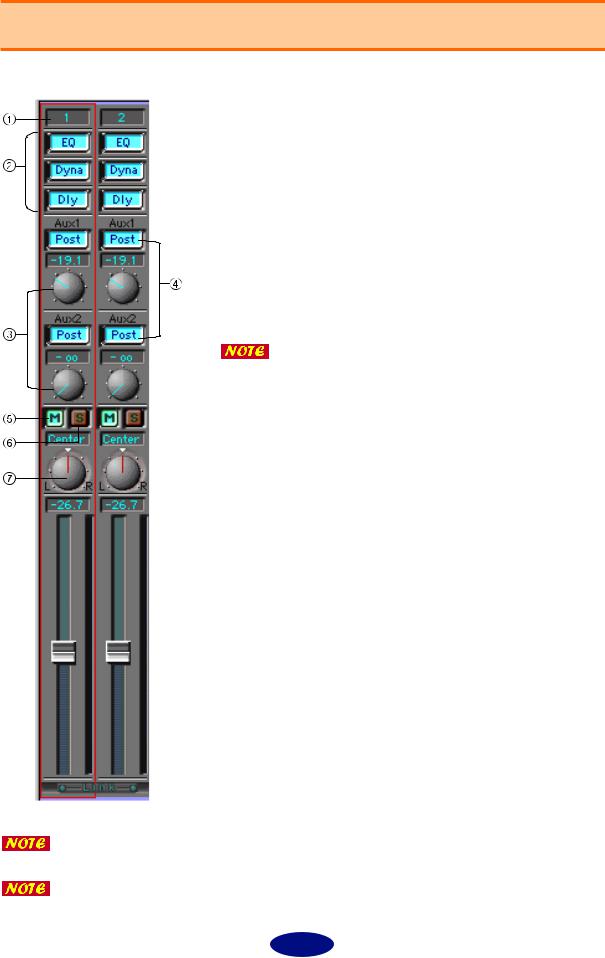
Input Channel Settings (Input Section)
You can adjust the input signal level and effect on/off for each channel.
AChannel number
Channels 1-8 are used for input signals via mLAN. Channels 9 and 10 are used for Digital input signals, and channels 11 and 12 are used for A/D input signals.
BEQ/Dyna (Dynamics)/Dly (Delay) button
These buttons are used to switch EQ, Dynamics, and Delay on and off for each channel. The settings are linked with the buttons in the Channel tab.
CAux 1/2 send knobs
These knobs are used to adjust the level of each channel signal sent to AUX 1/2.
Use these knobs when you are sending signals to an external effect processor or when you are monitoring signals with a balance that is different from the stereo output balance.
If you are using the mLAN8P: Signals sent to AUX2 are also sent to the internal multi-effect processor.
When AUX Layer is turned on, you can set AUX 3-6 parameters (mLAN8E).
DPre/Post buttons
These buttons enable you to select a pre-fader (Pre) signal or a post-fader (Post) signal as the AUX send signal. With the “Pre” setting, a signal is sent to the AUX bus before it reaches the channel fader; thus the signal is not affected by the channel fader setting. With the “Post” setting, a signal is sent to the AUX bus after it passes through the channel fader; thus the signal is affected by the channel fader.
EM (Mute) button
Press this button to mute the corresponding channel signal.
FS (Solo) button
Press this button to monitor the corresponding channel signal.
Press this button while holding down the Shift key to monitor multiple channel signals.
GPanpot knob
This knob enables you to set the stereo position of the corresponding channel. If the channel’s Link switch is set to “ON,” the knob adjusts the signal balance.
You can set the attenuation and phase independently for each channel, even when the Link switch is turned on.
When adjacent channels are linked, the panpot knob enables you to adjust the level balance between the odd and even channels.
7
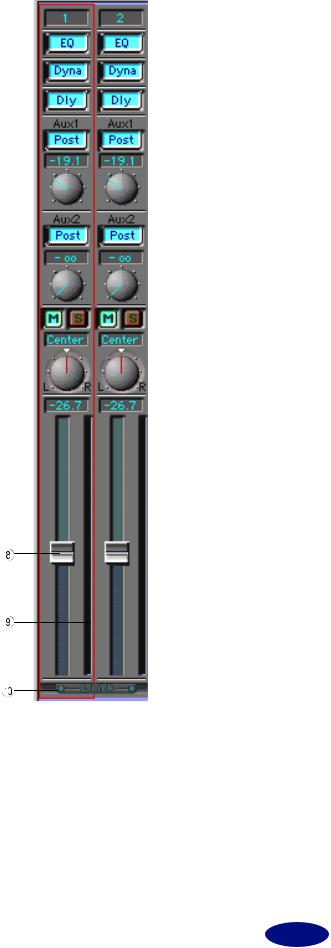
HChannel fader
The channel fader enables you to adjust the channel level. Click and hold down the mouse button on the fader and slide the mouse up and down, or click a desired point on the fader to move the fader to that point.
IChannel level meter
The channel level meter is displayed on the right side of the channel fader. The channel meter source is always the signal just after the gain, so the channel level meter displays the level of the input signal and is not affected by the EQ, Dynamics or the fader.
JLink (Link switch)
When this switch is turned on, adjacent channels (1 and 2, 3 and 4, etc.) are linked to each other for stereo operation.
8

Master Track Settings (Output Section)
In this section, you can set the stereo out fader, AUX master level, and effect return level.
AMute button (mLAN8P only)
Press this button to mute the return signal from the internal multi-effect processor.
BEffect RTN (mLAN8P only)
This knob adjusts the amount of signal processed by the effect processor and routed to Stereo Out.
The mLAN8E features an AUX Layer button instead of this button. When you turn this button on, you can set AUX 3-6 parameters for both input channels and the master track.
CLink button
Set this button to ON to link the AUX 1 and 2 settings. When they are linked, the panpot setting of the corresponding input channel is used. This is useful when you wish to use AUX 1 and 2 as individual stereo outputs.
DAUX 1/2 Master
These are used to adjust the level of the AUX 1 and 2 return signals.
When AUX Layer is turned on, you can set AUX 3-6 parameters (mLAN8E).
EMute button
Press this button to mute the stereo mix output.
FBalance
This knob adjusts the left and right balance of the stereo mix output.
GStereo mix fader
This fader adjusts the level of the stereo mix signal. Click-and-hold the mouse on the fader and slide the mouse up and down, or click the desired point on the fader to move the fader to that point.
HLevel meter
The level meter is displayed on the right side of the fader. The meter source signal is specified by the Mix Meter Source parameter.
9
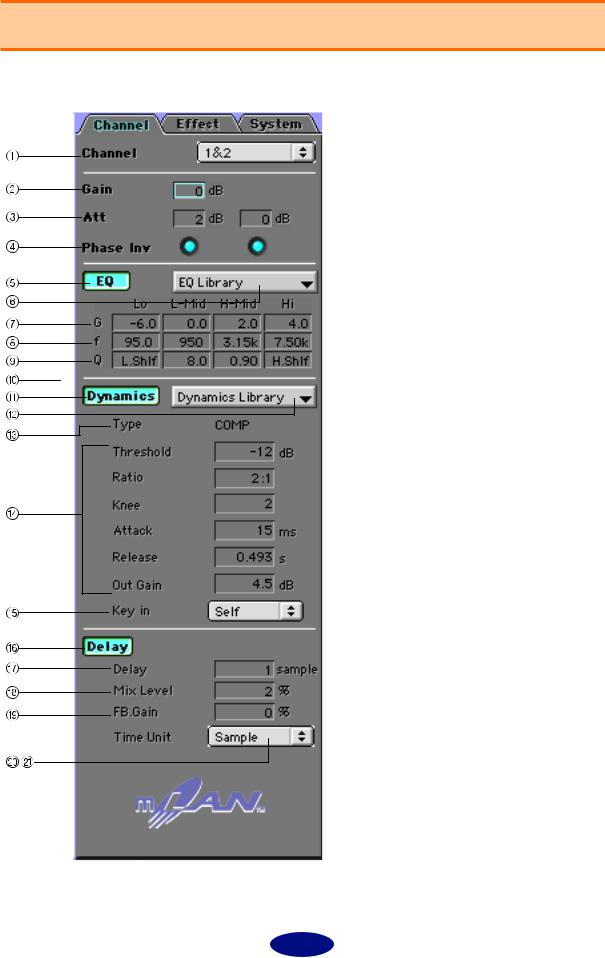
Channel Tab Window
mLAN Mixer offers the parameters independently for each channel, making detailed mixing operations possible.
AChannel (Target Channel)
Select the channel you wish to set here. Click the desired input channel module to display the corresponding channel number here automatically.
BGain
This parameter enables you to adjust the input level in steps of 6dB. Internally, mLAN Mixer performs a Bit Shift process.
Settings: –12 – +24dB
CAtt (Attenuator)
This parameter enables you to set the input level in steps of 1dB. In this way, you can fine tune the Gain value.
Settings: –96–+24dB
DPhase Inv (Inverted)
Click the check box to reverse the phase of the input signal.
10

 EQ (Equalizer)
EQ (Equalizer)
EEQ button
This button turns the selected channel EQ on or off. It is linked to each channel’s EQ button.
FEQ Library
This parameter enables you to select a preset EQ type.
GG (dB)
This parameter sets the amount of boost (+) or cut (–) of the signal at the specified frequency (F (Hz)). Settings: –18–+18dB (in steps of 0.5dB), ON/OFF (only when [HPF] or [LPF] is selected for the “Type” parameter with the Macintosh version.)
HF (Hz)
This parameter sets the equalizing frequency.
LO: ................... |
21 (Hz) – 20.0 k(Hz) |
L-MID: ............ |
21 (Hz) – 20.0 k(Hz) |
H-MID: ........... |
21 (Hz) – 20.0 k(Hz) |
HI: .................... |
21 (Hz) – 20.0 k(Hz) |
IQ
This parameter sets the frequency range for boost and cut. The higher the value is, the smoother the changes in the specified frequency range. With the Macintosh version, use this parameter to make the setting for “Type.”
Settings: 10.0–0.10
JType (Windows only)
This parameter enables you to select a type of EQ.
With the Macintosh version, set the Q value (9) to the maximum or minimum to select a Type.
[LO]
PEAK (peaking): LSLV (low-shelving): LPF (low pass filter):
[HI]
PEAK (peaking): HSLV (high-shelving): HPF (high pass filter):
A normal parametric equalizer
A shelving-type equalizer that boosts and cuts the signal in the low range.
A filter that cuts the frequency range above the threshold specified by the “F (frequency)” parameter.
A normal parametric equalizer
A shelving-type equalizer that boosts and cuts the signal in the high range. A filter that cuts the frequency range below the threshold specified by the “F (frequency)” parameter.
mLAN Mixer uses a 4-band full parametric equalizer. Basically, a parametric equalizer changes a tone by boosting (+) or cutting (–) the signal at the specified frequency. Boosting emphasizes the corresponding frequency range, and cutting attenuates the range. mLAN Mixer offers many presets suitable for various applications. Select one that suits your application, and fine tune it for quick operation.
 Dynamics
Dynamics
KDynamics button
This button turns the dynamics processor of the selected channel on or off. This button is linked with each channel’s Dynamics button.
LDyna (Dynamics) Library
Select the desired Dynamics type (page 34).
11
